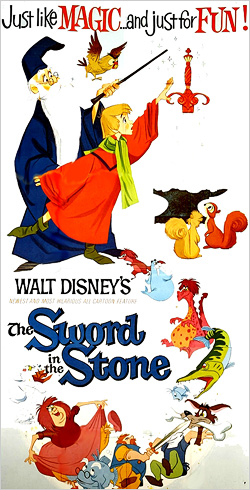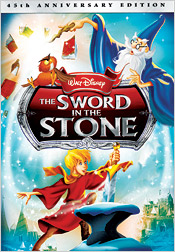 |
Site created 12/15/97.

page created: 7/9/08
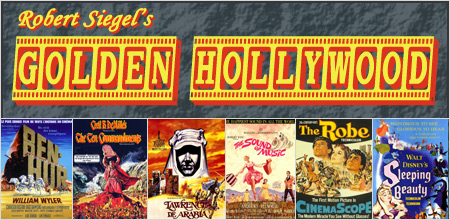 Robert Siegel - Main Page NOTE: The scans below are the property of Robert Siegel and The Digital Bits, and may not be reposted without permission. Copyright of the images belongs to the respective studios. In addition, please note that all the information contained within the text is taken from ORIGINAL studio press materials, which may contain some errors. |
||
Disney's The Sword in the Stone
Film appreciation by Robert Siegel of The Digital Bits The first animated cartoon feature flickered on the screen in 1906. Walt Disney took notice and was the first man who was able to perfect the medium in 1937 with his first full-length feature Snow White and the Seven Dwarfs. Twenty-six years later, the Disney studios released The Sword in the Stone which is now available as a 45th Anniversary Special Edition from Walt Disney Home Entertainment. [Continued below...] |
||
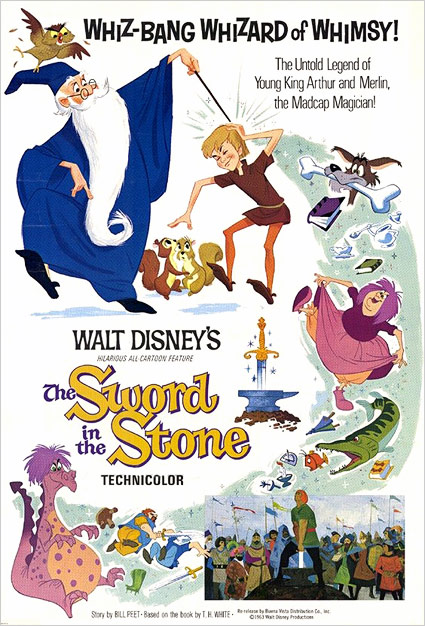 |
||
Based on the widely-read book of the same name by T.H. White, the film relates the story of King Arthur's boyhood and his adventures with Merlin, the prophet, magician, and benefactor of the young king. Filmed in brilliant Technicolor, The Sword and the Stone was adapted and
written for the screen by Bill Peet, artist-writer and veteran of twenty-six years with the Disney Studio. In adapting this work, Peet remained true to the author's original concept and the result is a tale contrasting life in the Fifth Century with that of the Twentieth Century. Although born in Grandview, Indiana, Peet spent most of his young life in Indianapolis where he was educated
at Tech High School and received his art training at the John Herron Art Institute. He then went on to work for a greeting card company followed by his own studio doing free-lance art work. [Continued below...] |
||
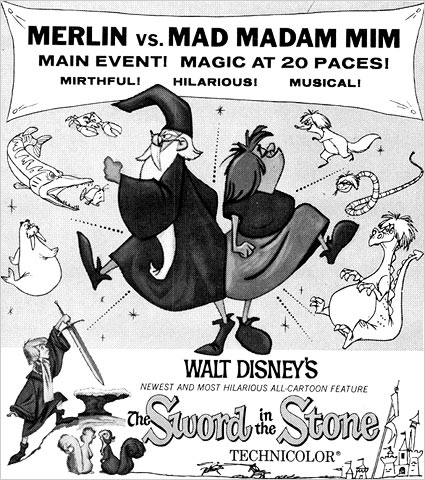
|
||
The Sword in the Stone was first published in 1938 and immediately became a book-of-the-month club selection. Since then, author T.H. White has revised and re-written the novel and then concluded his stories into a saga called The Once and Future King. White, whose given name is Terence Hanbury was an ex-public school teacher who was born in Bombay, India and was educated at Cheltenham College in England and Cambridge University, where he took first class honors with distinction in the English tripos. He began earning his living as a schoolmaster
at Stowe Ridings, Buckinghamshire, while trying to establish a literary reputation by working on his novels during vacation. In time, his efforts were recognized and in addition to The Sword in the Stone, other novels he wrote included Mistress Masham's Repose, The Goshawk, The Scandalmonger, The Witch in the Wood and The Ill-Made Knight. In talking about his career, he said, "Success in popular literature is a matter of good luck assisted by bad writing." Wolfgang Reitherman, who shared directing credit on such past Disney cartoons as Peter Pan, Lady and the Tramp, Sleeping Beauty and One Hundred and One Dalmatians, held the directorial reins along on this achievement. This marked the first time in the history of the studio that a full-length animated cartoon had been entrusted to the care of one cartoon director. Reitherman first ordered the plot laid out in a series of sketches, pinned in sequence on a large board with dialogue designated below each drawing. Once the boards were completed, they were transferred to his office who called a meeting with Walt. Then came a second meeting with the two plus the animators, background artists, layout men and musicians that were assigned. The story revisions were made at this time and each man was made aware of his exact responsibilities on the entire project in detailed memos. The animator, however, did not begin to draw the action sequences until the characters were set, the background layouts finished and the dialogue, music and effects recorded. When Reitherman was satisfied with those, he ordered a chart prepared to show in terms of single frames of film, the length of each word, the intervals between words, inhalations and exhalations and accents. [Continued below...] |
||
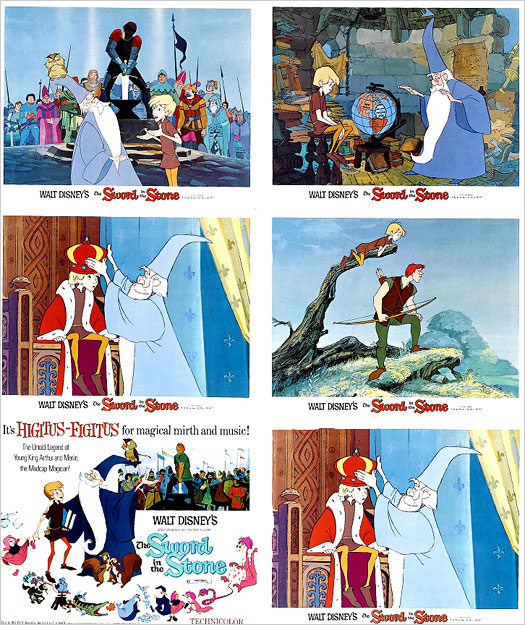
|
||
A complete series of drawings was then photographed by the stop-motion camera. The animators studied these rough tests for smoothness of action and overall effect, and then it was sent for approval to Reitherman. Once the test drawings were approved, they were sent to Disney's
Xerox department where they were transferred to sheets of celluloid through a special process. Every artistic subtlety made by the artists's pencils was preserved. The sheets of celluloid, or "cells" as they were famously called at the Disney Studios, were then sent to the painting department where a staff of 203 highly skilled women applied the chosen colors to the reverse side of the drawings. Paints used in the Disney cartoons were always ground and mixed within the studio paint laboratory from special formulas, and the colors and shades of paints used in this production totaled over 2100. When each scene was completed, the cels were packaged and sent
to the camera department where they were photographed one more time over the proper painted background by a stop-motion Technicolor camera, which recorded only one frame of film per exposure. Upon completion of photography, the scenes were spliced together and synchronized with a pre-recorded soundtrack, containing the dialogue, sound effects and music. Once checked and approved by the Director and by Walt himself, the picture and tracks were sent to a color lab for the final processing of prints. For The Sword in the Stone, this entire process took more than two years from concept to completion.
[Continued below...] |
||
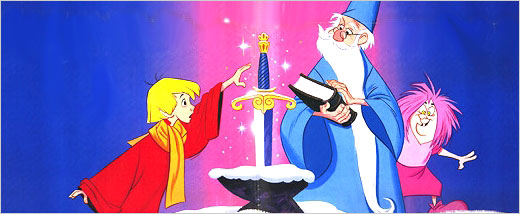 |
||
One of the top animators in the animated cartoon field was veteran Disney artist Milt Kahl, whose character design and expert animation were very important contributions to The Sword in the Stone. A member of the Disney team for over 30 years, Kahl referred to the success of Walt and his endeavors as "the doggonest achievement in cooperation ever heard of." Looking back on some of the characters he helped create, among them Cinderella, Peter Pan, Alice of Alice in Wonderland and many of the characters from Lady and the Tramp and One Hundred and One Dalmatians, Kahl, like other members of the Disney staff was quick to say, "You might say that animators are artists who make animated drawings. This would be a nutshell definition, but it only tells a part of the story. You could just about write a book about what an animator does. You could actually say that we are the actors or that we are the parents of the stars like Goofy, Mickey, Donald and the rest. We create the characters and their personalities, all of course inspired by the boss (Walt) himself." He went on to say that, "Some people who have watched us hammering out the identity of a princess, a squirrel, or a dragon-perfecting every little quirk of voice and behavior- have compared the process with writing a good piece of fiction. Well, it's something like that, but the big difference is that instead of having one creative mind working alone, we have a team of minds." Pointing to a sheet of sketches for this film, he went on to say, "These are the physical specifications for Merlin, the star of the picture, drawn from all angles and including details of his eyes, nose, beard and costume. And here are some of the hundreds of preliminary sketches we made before we all huddled at a story meeting and decided exactly how the old boy should look."
[Continued below...] |
||
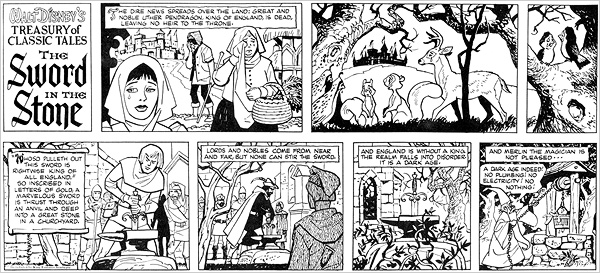 For months, Disney offered newspapers a regular weekly cartoon strip based on Sword in the Stone. |
||
A group of talented performers were rounded up by Walt to provide the voices for the film. Heard but not seen was the voice of Sebastian Cabot in the role of Sir Ector. Cabot claimed, "I first started out when I went to a repertory company in England and asked for a job, telling them I had experience. They gave me a job and then fired me within 48 hours. This happened several times over and though I didn't work at those jobs very long, I gained experience to put on my resume." As a result of his perseverance, he went on to tv and film. This first theatrical job was a repertory company presentation at Dover. He discovered he had a penchant for the dramatic. He performed for months with the BBC repertory company and then branched out as a free-lance radio actor for three years. His first contact with the American entertainment world came when he recorded numerous commercials in England for American radio. He then went on to a series
of good roles on the London stage. The silver lining finally came when the actor was given the exciting role of Lord Capulet in the film Romeo and Juliet starring Laurence Harvey. He then appeared as Porthos in an Italian film The Queen's Musketeers and then in MGM's Kismet. Disney saw his work in Romeo and Juliet and brought him to Hollywood for roles in Westward Ho, The Wagons and Johnny Tremain. Numerous offers also came from television producers and he spent several seasons playing in the series Family Affair. |
||
|
||
The Disney song-writing team of Richard M. and Robert B. Sherman presented six songs in the film. Under contract to Disney studios for some time, the Shermans were turning out one hit after another. In addition to writing hit tunes for recording artists Annette, Doris Day and Fabian, they were commissioned by Disney to compose songs for many of his films including The Jungle Book, Bedknobs and Broomsticks, The Happiest Millionaire, The Parent Trap, Summer Magic and Bon Voyage, to name a few. Upon completion of the music for The Sword in the Stone, the Sherman Brothers went on to write what is probably their most well-known full score for Disney's Mary Poppins, for which they won the Academy Award. There were actually eight songs written by the Shermans for the film but it was later decided to cut two of them before actual production began.
[Continued below...] |
||
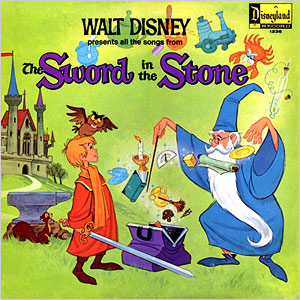 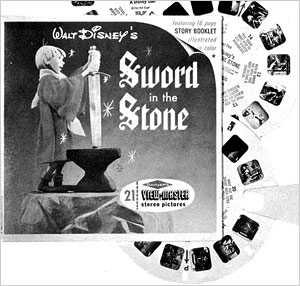 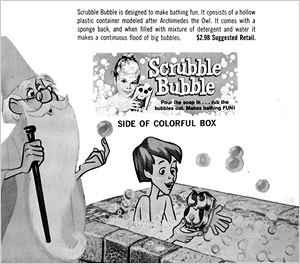  Disney promoted The Sword in the Stone in much the same way films are promoted today, with manufacturer and product tie-ins. |
||
Talented composer George Bruns celebrated his tenth year with the Walt Disney Studio with the completion of the score. This was Disney's third feature to use his talents for the musical score including Sleeping Beauty and One Hundred and One Dalmatians. Since joining the Disney organization in 1953, Bruns made important contributions to many of Disney's television shows including The Mickey Mouse Club and created the theme for Davy Crockett which has become a standard. Among his live-action feature scores were The Absent Minded Professor, Babes in Toyland and Son of Flubber. Bruns was born on July 3, 1914 in Sandy, Oregon. He began to study music on the piano when he was six years old and took up the bass tuba in high school. In 1932, he entered Oregon State and played with the band and school orchestra until he left in 1934 to become a professional on the piano, tuba and trombone. He toured the country with name brands until 1941 when he went to work as a shipyard layout man. After the war, he played and arranged for Jack Teagarden, later worked at Portland's radio station as an arranger and finally went to Los Angeles in 1950. There he organized a small combo, worked in night clubs, and composed most of the background music for his wife, then a Capitol Records vocalist known professionally as Jeanne Gayle. It was this that made Walt Disney take notice and he was hired to start scoring for the Disney Studios.
[Continued below...] |
||
 |
||
Reflecting on The Sword and the Stone after its release, Walt Disney, while promoting the film, said, "I take great pride in the artistic development of cartoons. Our characters are made to go through emotions which a few short years ago would have seemed impossible to secure. Some of the action produced in the finished cartoon is more graceful than any human could do. Fantasy, if it's really convincing, can't become dated for the simple reason that it represents a flight into a dimension that lies beyond the reach of time. In this new dimension, whatever it is, nothing corrodes or gets run down at the heel or gets to look ridiculous like, say, the celluloid collar or the bustle. And nobody gets any older."
[Continued below...] |
||
 |
||
|
||
Robert Siegel - Main Page
 |
| Site
designed for 1024 x 768 resolution, using 16M colors and .gif 89a
animation. © 1997-2015 The Digital Bits, Inc., All Rights Reserved. billhunt@thedigitalbits.com |
